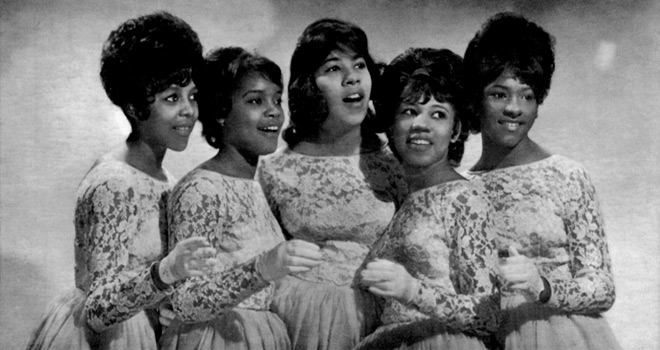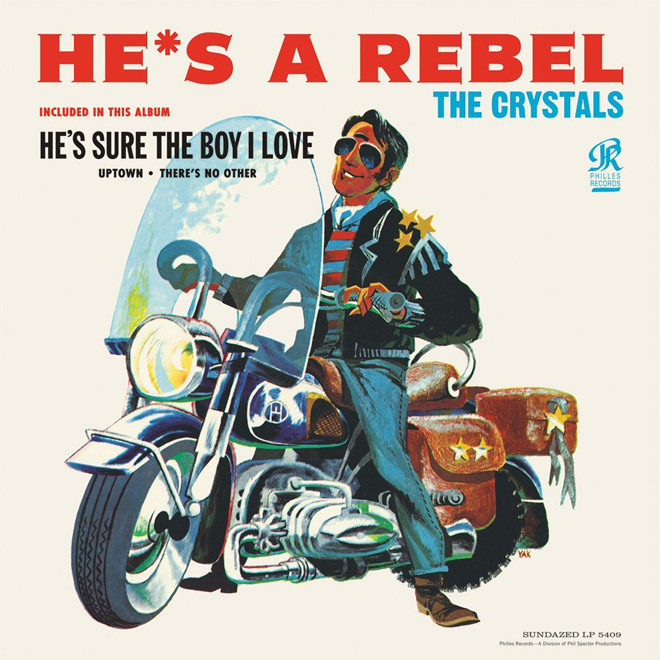
Some of the more memorable ones from that era included The Chordettes (“Mr. Sandman”), The Shirelles (“Will You Love Me Tomorrow?”), The Crystals (“Then He Kissed Me”), The Ronettes (“Be My Baby”), and The Shangri-Las (“Give Him a Great Big Kiss”). In fact, the sunny, shiny songs of these lovely throwbacks were a significant part of the sonic blueprint of the aforementioned contemporary groups, as well as that of many New Wave, Indie Pop, and Twee Pop bands that emerged in the 1980s onwards, such as Altered Images (“We Could Be Happy”), The Darling Buds (“Hit the Ground”), The Primitives (“Thru the Flowers”), Voice of the Beehive (“Don’t Call Me Baby”), and Camera Obscura (“Honey in the Sun”). Among the cited ’60s-popular groups that deserves a revisit this year is The Crystals, whose album He’s a Rebel has just turned 55!
Formed in 1961, in New York, United States, The Crystals were among the so-called Phil Spector–influenced groups during that era. They released their first full-length, Twist Uptown, in 1962. However, because of the commercial success in the latter part of the same year of the group’s then new single “He’s a Rebel,” the debut album was repackaged and re-released in 1963 as He’s a Rebel, which turned 55 this month. The Crystals in this second and final studio album of theirs were comprised by Barbara Alston, Mary Thomas, Dolores Brooks, Patricia Wright, and Darlene Love.
Released in February 1963, He’s a Rebel consisted of nine tracks from Twist Uptown plus the hit title track and a couple more songs. It opened with the sunny, upbeat Gene Pitney-written title track, which landed on the number-one spot on the Billboard Hot 100 chart in November 1962. It was followed by another successful single, the Surf/Flamenco-inspired “Uptown,” whose lyrical content, involving a minority living in the slums, contributed to the socially conscious slant of many Rock ’N’ Roll songs in the years that followed. Then there was the Tropical Soul–styled ballad “Another Country, Another World.” The next track, “Frankenstein Twist,” then prodded the listener to grab a partner and then run towards the dancefloor and do the shake and the twist.
Another bright, string-laden track, “Oh Yeah, Maybe Baby” fit well into the league of sunny, romantic, and mid-tempo female-sung songs that defined mid-’60s Pop. Closing Side One of He’s a Rebel was the second single, the horn-adorned “He’s Sure the Boy I Love,” which exuded faint echoes of Neil Sedaka’s “Calendar Girl.”
Side Two set the listener into a starry-eyed predisposition with “There’s No Other (Like My Baby),” cuing for the lights to be switched off or, at the least, be turned dimmer, so that the dancing couples could then merge into one body swaying gracefully like waves to the rhythm of the slow ballad. It was popularly covered by The Beach Boys to be included in their 1965 album Beach Boys’ Party! With “On Broadway,” The Crystals then continued the journey to something theatrical and Vaudeville, only to revert to the lovers’ nest with the even slower swing of “What a Nice Way to Turn Seventeen,” predating future seventeen-themed songs such as Janis Ian’s “At Seventeen,” Stevie Nicks’s “Edge of Seventeen,” Stray Cats’ “(She’s) Sexy & 17,” and Tommy Conwell & the Young Rumblers’ “I’m Seventeen.”
The sweet, mellifluous, and nostalgic pulse and heartbeat of “No One Ever Tells You” extended the listener’s stay on the dim-lit dance floor. The lights then gradually brightened up as the seemingly masochism-inspired song “He Hit Me (And It Felt like a Kiss)” tiptoed and pecked the listener’s lips in cold, funereal submission. The British band Spiritualized satirized this controversial song in 2005 with their own “She Kissed Me (It Felt like a Hit).”
Finally, The Crystals wrapped He’s A Rebel up with the Doo-Wop ballad “I Love You, Eddie,” which sang of old movies, teen dance, Betty, and…yes, Eddie, and all those cutesy, little girly whims, wishes, and insecurities that defined teen romance in the 1960s.
While the music of the current times as well as of the more recent decades are doubtlessly full of wonderful songs, the distant past should also not be forgotten. Realize that the world is now half a century away from the equally vibrant musical era of the 1960s. If we keep on ignoring the musical gems that may be mined from this half-forgotten time, letting them fade away in obscurity and eventually into oblivion, then we also slowly fail to remember the roots of whatever new music that we continue to enjoy today. Ultimately, we obliterate decades’ worth of music history.
So, pay the past a sincere and loving homage by revisiting classic albums that were made in a time that many seem to forget. Dig up a copy of the 55-year-old He’s a Rebel by The Crystals and go on an adventurous musical trip back to an era when being a rebel simply meant not doing what one’s peers were engaging in or falling in love against the wishes of one’s controlling and close-minded parents.
Welcome back to the sunny and bright but also sometimes gloomy and dark ’60s music scene. Yell and be a rebel in a positive way.






No comment